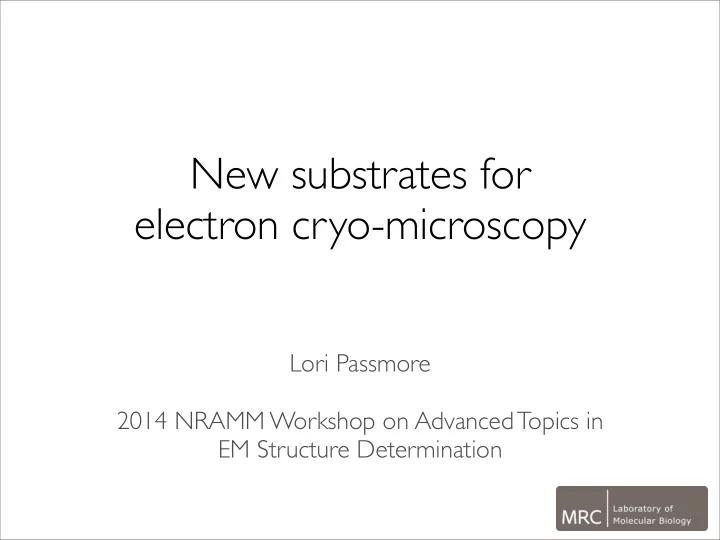

New substrates for electron cryo-microscopy Lori Passmore 2014 NRAMM Workshop on Advanced Topics in EM Structure Determination
Tradi&onal ¡substrates ¡for ¡cryo-‑EM electron microscope grid 80 μ m amorphous carbon membrane 1 μ m ice embedded metal grid bar protein particles Quantifoil, C-flat Cryomesh
Tradi&onal ¡substrates ¡for ¡cryo-‑EM electron microscope grid 80 μ m amorphous carbon membrane 1 μ m continuous ice embedded metal grid bar am. carbon fi lm protein particles
Plasma ¡chamber Plasma ¡created ¡by ¡ionisa1on ¡of ¡a ¡gas ¡under ¡low ¡vacuum ¡ E.g. ¡in ¡air ¡(glow ¡discharge), ¡oxygen, ¡argon, ¡hydrogen ¡
Tradi&onal ¡substrates ¡for ¡cryo-‑EM • Proteins ¡interact ¡with ¡surfaces ¡present ¡during ¡the ¡ blo@ng ¡process ➡ Denatura1on ¡of ¡proteins, ¡preferen1al ¡orienta1ons • Electron ¡radia1on ¡induces ¡mo1on ¡of ¡the ¡par1cles ¡and ¡ substrates ➡ Image ¡blurring • Addi1onal ¡layer ¡of ¡carbon ¡reduces ¡signal ¡to ¡noise ¡per ¡ par1cle ¡ ➡ alignment ¡more ¡difficult • Overall ¡lack ¡of ¡reproducibility ¡from ¡grid ¡to ¡grid
Graphene ¡substrates ¡for ¡cryo-‑EM electron microscope grid 80 μ m amorphous carbon membrane 1 μ m graphene ice embedded gold grid bar protein particles
10 Å
70S Ribosomes on graphene as synthesised 1.2 μ m hole
So how do we make graphene more hydrophilic so we can use it for cryoEM? Partial hydrogenation : Russo and Passmore (2014) Nature Methods Graphene oxide : Pantelic, Stahlberg et al (2010) JSB, (2011) JSB, (2011) Nano Lett Aromatic functionalisation : Pantelic et al (2014) Appl Phys Lett Amorphous carbon: Sader, Rosenthal et al (2013) JSB
95 Hydrogen plasma 90 Contact angle (degrees) H + e – 85 H 2+ H 80 75 H 70 C C–C–C–C–C–C–C–C 65 0 20 40 60 80 100 120 140 160 Hydrogen plasma exposure time (sec) Graphene 21 eV bond Russo & Passmore (2014) Nature Methods
graphene ¡+ graphene ¡+ graphene ¡+ no ¡graphene 10 ¡s ¡hydrogen 20 ¡s ¡ ¡hydrogen 40 ¡s ¡ ¡hydrogen
Human 20S proteasome on graphene no graphene
Apoferritin on graphene no graphene
b 1 amorphous carbon: before motion correction after correction graphene: before motion correction after correction FSC 0.5 80S 0.143 0 10 5.2 5.0 3.6 2.7 6.1 5.1 1/Resolution (Å) 20 thousand particles 5.2 Å without motion correction, 5.0 Å with
Ribosome speed plots Exposure time (ms) Exposure time (ms) Exposure time (ms) 0 300 600 900 900 0 0 300 600 900 0 0 0 300 600 900 6 Amorphous carbon Unsupported ice Graphene 5 ) Å ( t n 4 e m e c a l p 3 s i d 0.14 Å/e – /Å 2 S M 0.18 Å/e – /Å 2 0.092 Å/e – /Å 2 R 2 0.47 Å/e – /A 2 0.50 Å/e – /Å 2 0.41 Å/e – /Å 2 1 0 0 3 6 9 12 15 15 0 0 3 6 9 12 15 15 0 0 3 6 9 12 15 Fluence (e – /Å 2 ) Fluence (e – /Å 2 ) Fluence (e – /Å 2 ) graphene amorphous carbon quantifoil on quantifoil on quantifoil
Graphene is an excellent support material for cryo- • EM, particularly as an alternative to thin amorphous carbon We can modify and control the surface properties • of graphene with low-energy plasmas Using graphene instead of amorphous carbon • reduces noise and radiation induced motion Russo & Passmore (2014) Nature Methods
Recommend
More recommend